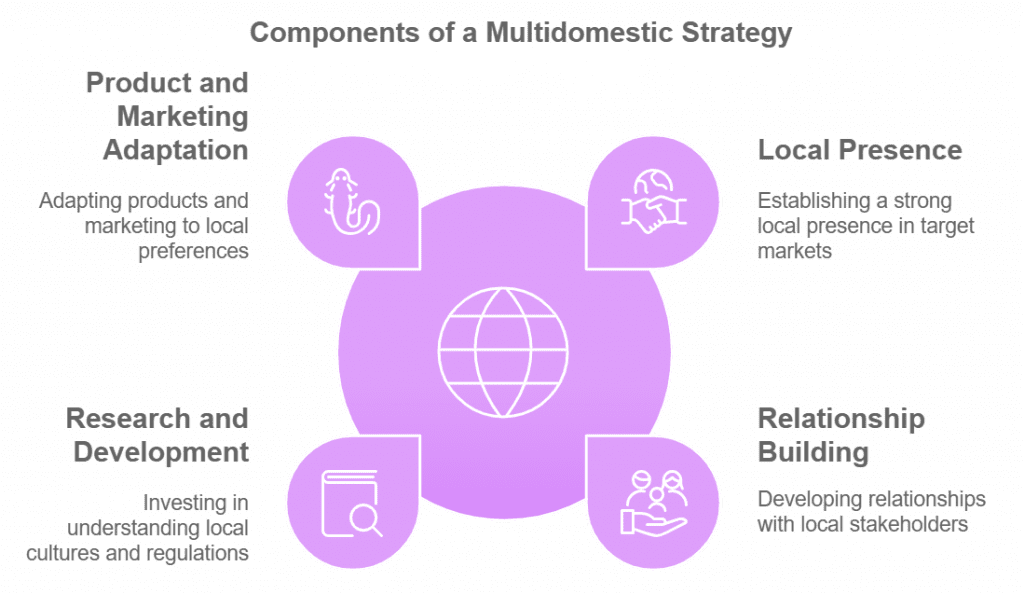Corinne Sharabi
Corinne is the Social Media and Content Lead at BLEND. She is dedicated to keeping global business professionals up to date on all things localization, translation, language and culture.

Expanding into new markets brings exciting opportunities but also complex challenges. A one-size-fits-all strategy often falls short in today’s culturally diverse world. Adopting a multidomestic strategy can help your brand connect with local consumers, meeting cultural expectations and regulatory requirements with ease.
Multidomestic strategy refers to when companies enter new markets while attempting to integrate with the societal, cultural, and legal specifics of those markets.
Here’s everything you need to know about how a multidomestic approach can drive global success.
A multidomestic strategy is a specific approach to marketing. More specifically, it refers to when brands use different marketing and sales strategies, as well as products themselves, which have been tailored to the needs and requirements of a target market. In other words, rather than presenting as a single global brand, businesses operate many different smaller brands that have been fine-tuned to better reflect local preferences and consumer behavior.
Brands have a few different options available when approaching multi-domestic marketing. One of the most common approaches is to keep things relatively globally focused. This means heavily preserving the essence of the parent brand, with few if any changes made for local markets. Alternatively, a multidomestic strategy may be more locally responsive, addressing the specific needs of different markets while accommodating unique local tastes and preferences.
A multidomestic strategy involves businesses establishing a robust local presence. This is done by developing relationships with suppliers and distributors, as well as customers, in each target market. Relationship-building requires deep insights into local cultures, including business practices and language specifics.

What’s more, a multidomestic business strategy involves significant investment in research and development. This ensures a full understanding of cultural and economic differences, as well as any variation in regulatory compliance. The time and financial investment involved in research and development can be considerable, but it’s an integral part of the process.
Another hallmark of a multidomestic strategy is the adaptation of brand and marketing messaging, as well as products themselves in some cases. These changes need to properly reflect local preferences and trends of a target market. Unsurprisingly, this calls for an intimate knowledge of local cultures, as well as consumer behavior in any given territory.

There are many reasons to consider investing in a multidomestic strategy. The most obvious of which is that by localizing products and services to accommodate local requirements and consumer appetites, businesses can cement a strong market position. As well as helping combat the competition, this boosts brand awareness and fosters consumer trust and customer loyalty.
Furthermore, multidomestic strategies help companies circumnavigate potential cultural and regulatory obstacles. By gaining a deep insight into local requirements, businesses can tweak their operation accordingly.

A multidomestic strategy also allows for a degree of innovation. Many companies may choose to decentralize key business elements like decision-making, giving teams in each region a certain autonomy. This level of flexibility increases local responsiveness, ensuring local teams are free to make changes that are better aligned with local preferences and best practices.
Multidomestic strategies also make it easier to compare regional markets with domestic ones. By doing so, companies may be able to make sweeping changes to their parent operation. What’s more, a multidomestic approach makes it simpler to determine which regions are proving successful. In doing so, it’s far easier to know which operations to wind down and which ones to upscale.
Mastering multidomestic strategy isn’t easy. If you’re looking to achieve growth in numerous markets and realize the full potential of your multidomestic strategy, you’ll need to be prepared for many pitfalls. Below are just some of the challenges you’re likely to encounter when implementing a multidomestic strategy.

Firstly, there are relatively high operational costs to consider. For example, implementing a multidomestic strategy in retail could mean different advertising budgets and product customizations for each market. There’s no shortage of elements that need to be budgeted for, including market research, product adaptation, and the financing of marketing campaigns. Furthermore, it’s likely you’ll need to employ the services of local talent and native-speaking consultants to get a full handle on the nuances of a target market.
If you want to penetrate multiple markets, localization is essential. However, it can prove incredibly difficult to maintain a consistent brand image across numerous markets. This is why so many companies choose to approach their multidomestic strategy with a global mindset, rather than a locally-responsive one.
Deploying a multidomestic strategy is a complex operation. Numerous obstacles can derail a project, including adherence to regulatory compliance, maintaining quality standards, and the language barrier itself. When compounded, these issues can spell the end of a multidomestic strategy for companies that are ill-prepared.
Although you’ll need to contend with many obstacles when delivering a multidomestic strategy, many multinational companies have proven it’s possible to succeed. Looking to take a local-first approach? Below, we’ll take a closer look at a few brands that have nailed multidomestic strategy.

First up is the confectionery company Nestle. The business comprises more than 2000 smaller food and beverage brands, including Häagen-Dazs and Purina. Nestlé tailors its food and beverage offerings to match local tastes and dietary preferences, selling unique products in different markets. Today, Nestle sells to consumers in more than 180 countries, with available brands cherry-picked for each market based on local preferences.
Johnson & Johnson is another household name that excels at multidomestic strategy. The parent company of brands like Tylenol, Splenda, and Neutrogena, Johnson & Johnson offers its brand portfolio successfully in more than 60 countries, adapting its marketing and product variations based on the health needs of each region it serves. Procter & Gamble adopts a similar approach, with a portfolio of more than 250 brands. As of 2024, the company operates in more than 140 countries, offering popular brands such as Gillette, Pampers, and Olay.
The first step in creating and deploying a multidomestic strategy is to understand your target market. You’ll need to carry out in-depth research into local demographics, cultural norms, and consumer behaviors. Surveys and interviews, as well as readily available analytics can all be used to assist with market research.
Next, you’ll need to actually adapt products themselves. Generally speaking, most products will need to be tailored to accommodate local markets to some extent. Once product adaptation is completed, you can start localizing your marketing campaigns. Chances are, things are going to deviate heavily from your original marketing messaging. You’ll need to create messaging that fully resonates with new audiences in their native language, rethink colors and imagery, and more.
With your m marketing campaigns fine-tuned for new markets, you’re ready to approach regulatory compliance. It’s crucial that you understand and adhere to the laws and regulations of your target market. This includes things like privacy law requirements. To truly make a success of a multidomestic strategy, you’ll also need to be using the best technology. Use localization tools that automate processes to streamline workflows and expedite delivery or make quick work of market research with interactive online surveys that can be shared and completed remotely.
If you want to increase the odds of success as you expand into new markets, you’ll need to adopt a multidomestic strategy. When properly deployed, multidomestic strategies make it far easier for brands to solidify a strong local presence and create products and content that resonates with local consumers.
A well-executed multidomestic strategy is a powerful tool for building a strong local presence and connecting with consumers on a cultural level. By adapting to each market’s unique needs, you enhance brand loyalty and stay competitive. Ready to leverage the benefits of a multidomestic approach? BLEND’s expertise in translation and localization can help you navigate every aspect of international expansion. BLEND’s suite of industry-leading tools and technologies will simplify your workflows, automate time-intensive processes, and dramatically reduce the margin for error.
Reach out today to learn how we can support your global success.
Adopting a multidomestic strategy decentralized organizational structure, giving teams in each market a level of autonomy when it comes to making key business decisions.
Although any brand can potentially benefit from a multidomestic strategy, some do more so than others. The food and beverage industries, along with wellness and retail, are typically set to gain by employing a multidomestic strategy.
Technology can be used to support every facet of a multidomestic strategy. Online surveys and interactive questionnaires can be used for market research, while machine-assisted translations can reduce the burden on human linguists when it comes to translating text from one language into another one.
What our customers are saying